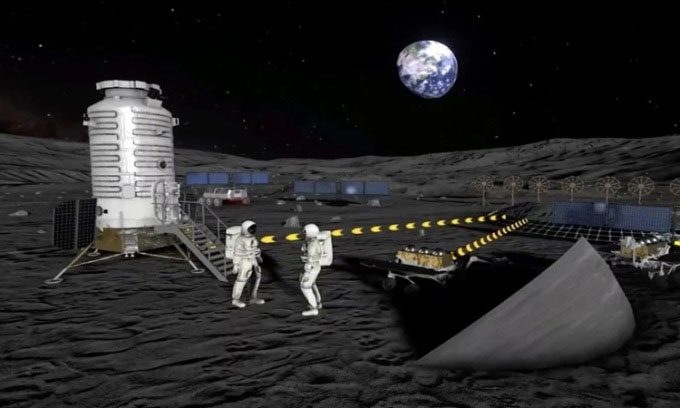China is set to develop a satellite network around the Moon for real-time, precise positioning, which will facilitate the exploration of the lunar south pole.
A research team from the Beijing Institute of Spacecraft System Engineering has proposed the construction of a network of 21 satellites orbiting the Moon that can provide high-precision real-time positioning functions to support China’s missions, as reported by Interesting Engineering on July 14. These satellites will be deployed in four types of orbits over three phases, designed to be sustainable and cost-effective. Although the research team did not specify a timeline for construction, China aims to send astronauts to the Moon by 2030 and establish a base at the south pole with international partners by 2035.

Simulation of China’s positioning system will include 21 satellites orbiting the Moon. (Image: Astronomy).
“The constellation of satellites in lunar proximity can track every movement, takeoff, and landing activities on the surface, supporting high-frequency human exploration of the Moon in the long term,” said Peng Jing, the research team leader and deputy chief designer of China’s Chang’e 5 mission.
On Earth, global positioning satellite systems such as the U.S. GPS and China’s BeiDou are widely used, making it easier to locate positions and plan routes. Such systems typically consist of 20 to 35 satellites with an accuracy of a few meters. Each satellite transmits radio signals, allowing users to determine their location and time by combining signals from at least four satellites.
In their study, Peng and colleagues evaluated three main factors of the lunar positioning system, including signals from at least four satellites at any given time, location accuracy, and cost of construction and maintenance.
They found that in the first phase of construction, it is sufficient to place two satellites in highly stable elliptical orbits to ensure continuous communication between Earth and the Moon’s south pole, using minimal fuel to maintain operations once the satellites reach orbit.
In the second phase, by adding nine satellites and two types of orbits, this satellite constellation can provide continuous positioning for the Moon’s south pole, supporting 24/7 communication between Earth and any location on the Moon.
In the final phase, a total of 21 satellites will be placed in four types of orbits, allowing the complete satellite constellation to provide relatively accurate positioning anywhere on the Moon’s surface more than 70% of the time. The research team plans to optimize the parameters for each type of orbit and develop a more systematic design for the satellite constellation.
China has developed and deployed two communication relay satellites, Xu Qiao 1 and Xu Qiao 2, in lunar proximity to support missions exploring the Moon’s far side in recent years. The United States, Europe, and Japan have also announced plans to develop lunar positioning systems. For instance, Japan’s proposed system in 2022 includes eight satellites orbiting the Moon in elongated elliptical orbits for communication and positioning in the south pole region.


















































